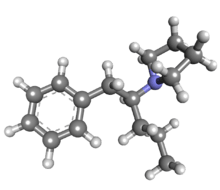Prolintane
Prolintane (Catovit, Katovit, Promotil, Villescon) is a stimulant[1] and norepinephrine-dopamine reuptake inhibitor developed in the 1950s.[2] It is closely related in chemical structure to other drugs such as pyrovalerone, MDPV, and propylhexedrine and it has a similar mechanism of action.[3] Many cases of prolintane abuse have been reported.[4]
 | |
 | |
| Clinical data | |
|---|---|
| Routes of administration | oral, intranasal, rectal |
| ATC code | |
| Identifiers | |
IUPAC name
| |
| CAS Number | |
| PubChem CID | |
| ChemSpider | |
| UNII | |
| ChEMBL | |
| ECHA InfoCard | 100.007.077 |
| Chemical and physical data | |
| Formula | C15H23N |
| Molar mass | 217.35 g/mol g·mol−1 |
| 3D model (JSmol) | |
| Melting point | 133 °C (271 °F) |
| Boiling point | 153 °C (307 °F) |
SMILES
| |
InChI
| |
| | |
Under the trade-name "Katovit", prolintane was commercialized by the Spanish pharmaceutical company, FHER. Katovit was sold until 2001, and was most often used by students and workers as a stimulant to provide energy, promote alertness and concentration.
See also
- α-PVP (β-ketone-prolintane, prolintanone)
- Methylenedioxypyrovalerone (MDPV)
- Pyrovalerone (Centroton, Thymergix)
References
- Hollister, L. E.; Gillespie, H. K. (March–April 1970). "A New Stimulant, Prolintane Hydrochloride, Compared with Dextroamphetamine in Fatigued Volunteers". The Journal of Clinical Pharmacology. 10 (2): 103–109. doi:10.1177/009127007001000205. PMID 4392006.
- GB Patent 807835
- Nicholson, A. N.; Stone, B. M.; Jones, M. M. (November 1980). "Wakefullness and reduced rapid eye movement sleep: studies with prolintane and pemoline". British Journal of Clinical Pharmacology. 10 (5): 465–472. doi:10.1111/j.1365-2125.1980.tb01790.x. PMC 1430138. PMID 7437258.
- Kyle, P. B.; Daley, W. P. (September 2007). "Domestic Abuse of the European Rave Drug Prolintane". Journal of Analytical Toxicology. 31 (7): 415–418. doi:10.1093/jat/31.7.415. PMID 17725890.
This article is issued from
Wikipedia.
The text is licensed under Creative
Commons - Attribution - Sharealike.
Additional terms may apply for the media files.